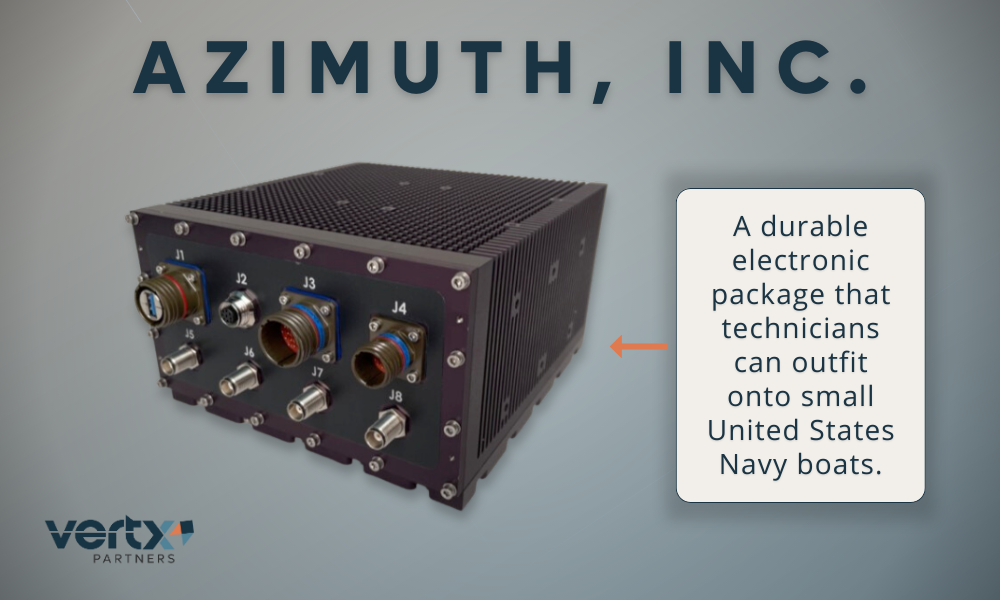Vertx Partners highlights five more federal contracting success stories that clients interested in SBIR/STTR awards will find inspiring.

At Vertx Partners, seeing is believing. Platitudes and promises of success are one thing – real-world success stories where ideas have come to life are another.
This guide is the second in a series that seeks to inform and inspire (read part one here). This series examines businesses and research institutions rewarded for keeping their finger on the pulse of federal contracting. Every year, more and more SBIR/STTR success stories come out. These stories illustrate businesses and their partners utilizing the Small Business Innovation Research (SBIR)/Small Business Technology Transfer (STTR) award to innovate and even change the world.
Here are five more for your consideration:
1. Azimuth, Inc.
Azimuth is trailblazing in the field of advanced naval boating. The company is an electronics and engineering firm that will prove interesting to our West Virginian readers: its founder based it a stone’s throw away from West Virginia University’s main campus. Despite offices in Virginia, Maryland, and North Carolina, Azimuth operates primarily out of Morgantown, WV, where the firm regularly employs a steady supply of talented engineering graduates.
Azimuth experienced early challenges characteristic of start-up companies but saw its “big break” when the U.S. Department of Defense (DoD) paired them with a more prominent Virginia-based firm for a mentorship program. Through the program, Azimuth was led to its first SBIR proposal. Then, the DoD tasked the company with developing a sophisticated, durable electronics package that technicians could outfit onto small United States Navy boats. Still enjoying success, Azimuth continues to hold long-term contracts related to that first SBIR.

2. Psychology Software Tools, Inc.
Based in Sharpsburg, PA, University of Pittsburgh researcher Dr. Walter Schneider and his former student Anthony Zuccolotto founded Psychology Software Tools (PST) to solve problems related to Magnetic Resonance Imaging (MRI) machines. One such challenge was the “fiber crossing problem.” In short, this was an issue with MRI that precluded doctors from accurately diagnosing patients with Traumatic Brain Injury (TBI).
In the mid-90s, PST received a Navy SBIR contract to develop a turn-key MRI system that established baseline diagnostic criteria for patients. With the funding from this SBIR, Schneider and his team solved the “fiber crossing problem” by allowing for more detailed brain mapping. This breakthrough technology assisted in diagnosing and treating combat veterans with TBI, drastically increasing survivability and reintegration.
3. Agentase, LLC (FLIR Systems)
Keeping in line with University of Pittsburgh-fielded technologies, Agentase was a small business commissioned by a U.S. Army STTR to develop an accurate, sensitive, low-cost, and easy way of detecting chemical contamination. With proper funding and access to University of Pittsburgh resources and researchers, Agentase developed a revolutionary spray; users apply the spray directly to surfaces to determine if a chemical agent has been administered.
The spray was so successful that FLIR Systems eventually bought it for a quarter of a billion dollars. Remarkably, nearly 20 years after its development, it continues to see military and civilian use. Dr. Stephen Lee, a key Army Research Lab scientist and early advocate of Agentase’s detection technology, is adamant that developers would never have created the spray without the STTR program’s assistance.
4. Diversified Marketing Group, Inc.
Also initially founded in Pennsylvania, Diversified Marketing Group (DMG) was awarded an SBIR from the United States Army following the 9/11 terror attacks to develop a lightweight closure mechanism for protection against CBRN (chemical/biological/radioactive/nuclear) threats. They quickly developed their patented FLEXSEAL technology using state-of-the-art zipper closures that met the Army’s specifications and exceeded them.

DMG enjoyed widespread commercial and federal success after developing FLEXSEAL as parts of its closure mechanism continue to be used across fields as varied as waterproofing garments for fishermen to OSHA PPE (personal protective equipment). SBIR funding incentivized the creation of such a versatile technology.
5. Microsensors Systems, Inc. (ENMET, LLC)
Hank Wohltjen founded Microsensors Systems after inventing the highly ingenious Surface Acoustic Wave (SAW) microsensor as a Virginia Tech graduate student. The sensor is essentially a tiny microchip that constantly vibrates at a specific frequency. Once a chemical agent saturates it, the chip resonates at a lower frequency. This acts as a triggering mechanism, alerting the user to exposure to potentially harmful chemical weaponry.
Originally started in Bowling Green, Kentucky, Wohltjen’s company secured an SBIR contract from the Defense Advanced Research Projects Agency (DARPA). Then, this contract allowed them to perfect this novel detection method, making it more sensitive, informative, and versatile. Since then, ENMET, LLC acquired Microsensor Systems, but Wohltjen attributes his company’s early success to the DoD SBIR contract. Multiple global entities deploy his technology as an early warning device for chemical attacks.
These are just five more examples of problem-solving funded by the Small Business Innovation Research/Small Business Technology Transfer programs. As you can see, each company started in an Appalachian state and diversified to other areas through its success.
Vertx Partners will continue to bring you SBIR/STTR success stories. Inspired by what you see here? Contact Vertx Partners today with our 6-minute survey, and one of our experts will contact you within 48 hours.
Become an Innovator With Us
Tell us about yourself, answer a few questions, and hit submit. It’s as easy as that to get started.
